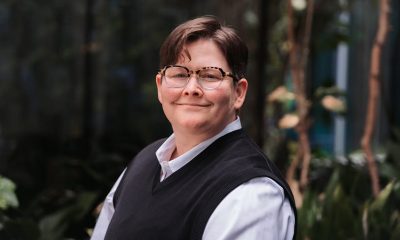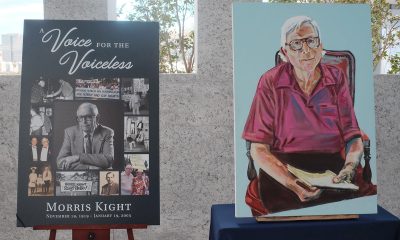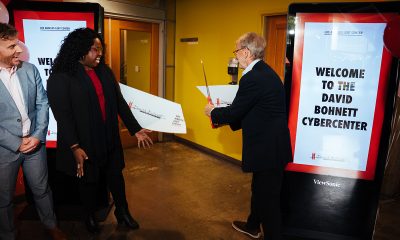News
Memorial for Rose Greene, lesbian checkbook activist, set for August 4
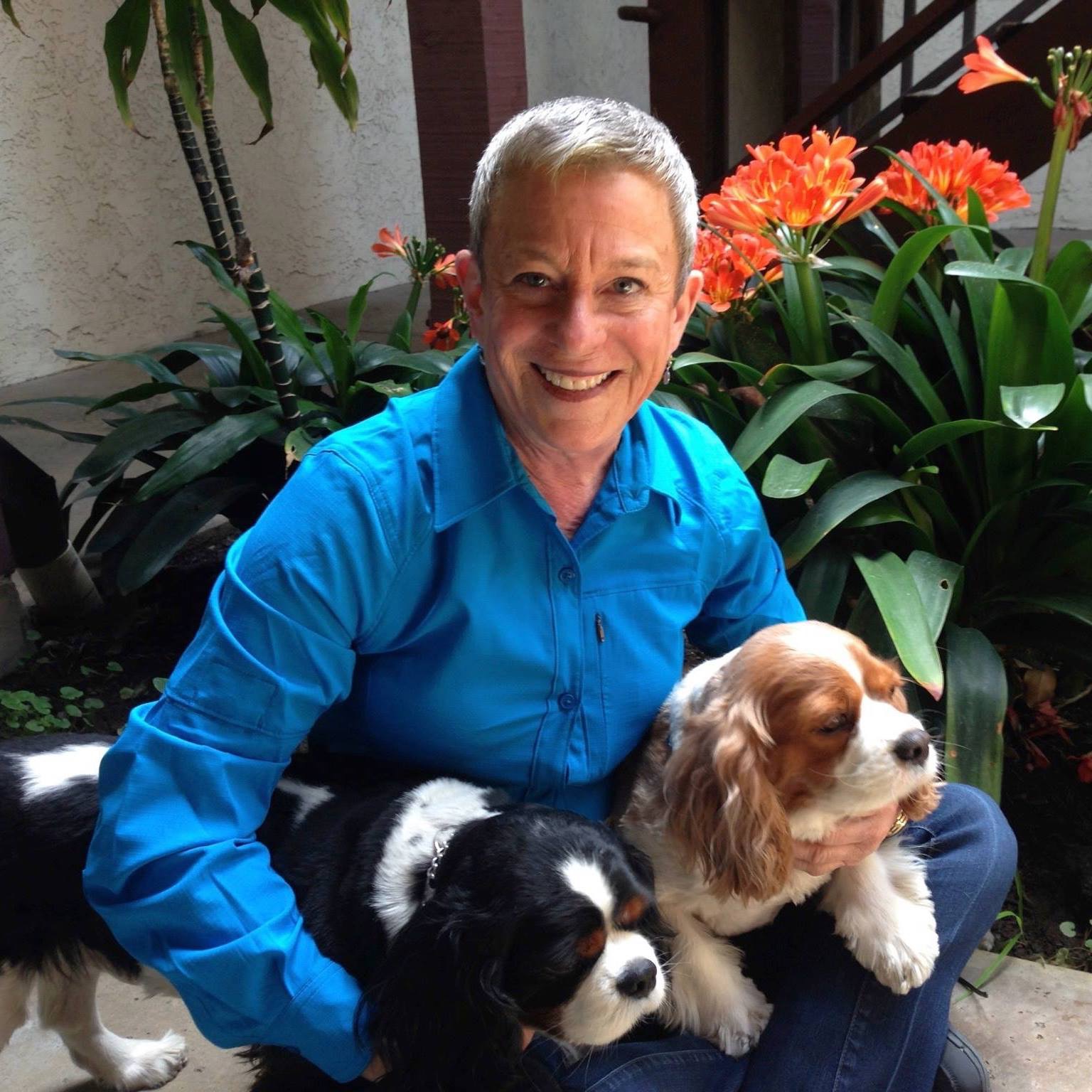
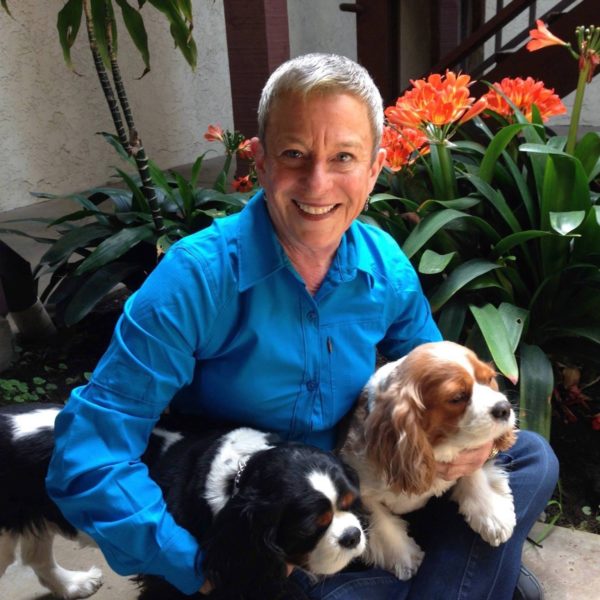
The LGBT community often fetes its celebrity top-donors at black tie and gown galas to show gratitude for helping grow or keep an organization afloat. Less well-recognized are the cadre of volunteer board members, checkbook activists who are just as dedicated to serving the LGBT movement as any grassroots activist, but other than a line at the bottom of their LinkedIn profile, prefer to lead and work in the background to make things happen.
Rose Greene was such a leader. She served twice on the Los Angeles LGBT Center’s Board of Directors from 1989-1995 and 2006-2011, critical times in the LA LGBT movement’s history. Only with her death on July 11 is the community learning the depth of her commitment and her contribution—which will no doubt be recounted at her memorial service on Sunday, August 4 at the Renberg Theatre at The Village at Ed Gould Plaza, 1125 McCadden Place in Hollywood. The service, officiated by Rabbi Denise Eger, will begin at 1 pm.
Greene died of bone cancer, said Lorri L. Jean, CEO of the Los Angeles LGBT Center. She was 72.
Rose Greene was an Angelino. Born in 1946 to a father who owned a cement company and a mother who died when she was 12, Greene attended Fairfax High School, graduated from Cal State Northridge in 1968 with a bachelor’s in fine arts, then briefly taught photography at Hamilton High School, according to an obituary in the Los Angeles Times.

In 1985, she graduated from the University of Southern California after studying personal financial planning. She subsequently founded her own business, Greene Group Financial, based in Santa Monica, which used a team approach to developing personalized plans for clients. She also promoted Community on her webpage.
“Rose believes passionately that one must give back to their community and encourages all of her clients to do the same. To that end, when Rose is not in the office, you’ll find her advising non-profits on their endowments and capital campaigns,” says the outdated post. She also believed in walking the talk.
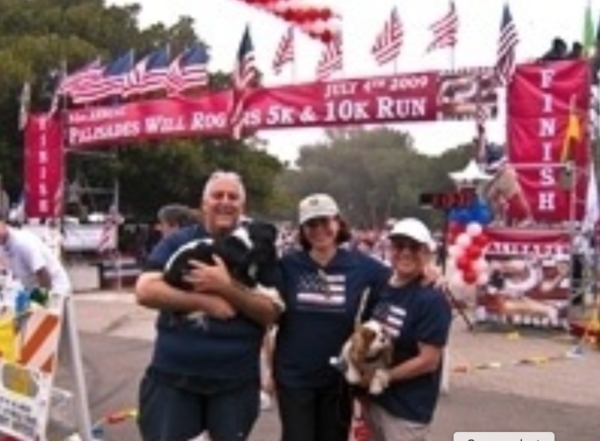
Rose Greene, Helena Ruffin, Cousin and Client Mark Samara (and Maggie and Gabriel of course) participate in the 32nd annual July 4th, 5k and 10K run/walk benefiting Will Rogers Park. Everyone crossed the finish line, Gabe and Maggie however needed a little escorting.
Greene came out in the 1960s, Jean told The Times. It was a time of significant political and cultural turmoil and change with protests against the war in Vietnam and the music revolution reflecting and fueling it from Frank Zappa; Jim Morrison and The Doors; Carole King; The Byrds; Buffalo Springfield; Crosby, Stills, Nash & Young; Joni Mitchell and so many others centered in LA, West Hollywood and Laurel Canyon on and just off the Sunset Strip.
And yet homophobia and homo-hatred were still a constant during the “Make Love, Not War” generation. There were still violent gay bars raids such as at the Black Cat Tavern in 1967 and the very public murder of a gay nurse named Howard Efland by LAPD cops at the SRO Dover Hotel in downtown LA on March 9, 1969—a murder the Coroner called an “excusable homicide.” There were also organized public protests by such out gay leaders as Rev. Troy Perry and Morris Kight, captured on film by film activist Pat Rocco.
It was against this backdrop that Rose Greene developed her sense of community spirit. She was always forthright and honest. She wasn’t afraid to be herself, Jean told The Times.
Women’s Liberation movement was also developing at this time and Greene’s path was actually more lesbian-feminist focused than gay.
“I recruited Rose to work on our first women’s event — the June Swoon — almost as soon as I became executive director [of the Los Angeles Gay and Lesbian Community Services Center] in 1888 and onto the Board shortly thereafter,” longtime LGBT and political activist Torie Osborn tells the Los Angeles Blade. “I’d known her from around the lesbian community since the ’70s. She was a passionate feminist who was highly skeptical that the Center could transform into a place welcoming lesbians, as well as gay men.
“I watched her become more and more of a leader, more and more of an advocate for the Center, and more and more outspoken and militant,” says Osborn. “When we all hit the streets in October of 1991, in response to Gov. Pete Wilson’s veto of AB 101 [the gay civil rights bill he’d promised to sign], there was Rose, angry and loud, chanting and marching with the rest of us. She served as female co-chair of the Board during my tenure and brought her terrific business acumen, great humor and common sense to us at a time we needed all of it. She carried the hopes and dreams of the lesbian-feminist world into the Center with power, passion and purpose. She was a key figure at a key time in Center history.”
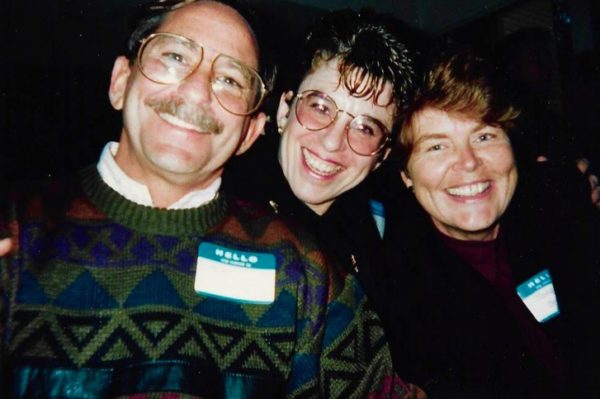
LA Gay and Lesbian Community Services Center Board co-chairs Ed Gould and Rose Greene with Center Executive Director Torie Osborn at event for the historic Capital Campaign. (Photo by Karen Ocamb)
Greene and Board co-chair Ed Gould followed the hard work of Board stalwart Karen Siteman who, with Mason Sommers, kicked off and led the first-ever LGBT capital campaign to buy the 44,000-square-foot old IRS building on the Hollywood street later renamed for longtime Center supporter and Board member, Judge Rand Schrader. Ironically, the IRS declined to grant the Center non-profit status in 1972, but did grant it on appeal after then-Center executive director Don Kilhefner promised that the Center would not advocate for homosexuality, only gay consciousness raising.
Schrader, who announced he was HIV positive in November 1991, joined LA City Councilmember Mike Woo, Board co-chair Ed Gould, Center Board member Will Halm (partially obscured in this photo), LA County Supervisor Ed Edelman, Center Board co-chair Rose Green (a stand out in white), actress Judith Light, Executive Director Torie Osborn, and LA County Assessor Kenny Hahn for the ribbon cutting ceremony in November 1992 for what became the Center’s headquarters at the McDonald/Wright Building.

Unbeknownst to most caught up in the historic ceremony was that the Center’s incoming executive director, attorney and FEMA San Francisco-based director Lorri L. Jean, was in the audience.
“I’ll never forget that day in the summer of 1992 when my San Francisco office phone rang, and it was Rose whom I had never met. Her mission was to recruit me to apply for the job of Executive Director at the Center. Her passion was infectious. Her commitment impressive. She succeeded, and that pivotal moment changed my life,” Jean says. The success of that first-ever Capitol Campaign “inspired others throughout the nation, among them the New York LGBT Center and the Human Rights Campaign.”
It inspired Greene, too, deciding to mount a second capital campaign to raise $15 million to purchase a $6.7-million Hollywood complex at 1125 N. McCadden Place and renovate it.

On June 21, 1998, it opened as The Village at Ed Gould Plaza, along with a $10-million endowment fund. Additionally, in 1993, Greene helped lead the Center in opening the Jeffrey Goodman Special Care Clinic, which expanded free and comprehensive early intervention HIV and AIDS medical care when AIDS was still crashing all around LA in the second wave of AIDS, according to Jean.
Perhaps Greene’s greatest legacy – that few know about – is her central significance in creating and developing the first California AIDS Ride in 1994. The 545-mile bike ride from San Francisco to Los Angeles, now known as the popular AIDS/LifeCycle, has raised more than $280 million for HIV/AIDS- related services at the Center and the San Francisco AIDS Foundation.
But it took Rose Greene to trigger the launch.
In an email to friends and supporters, Dan Pallotta, now leader in “transformation technologies,” writes about how he “originally developed the concept of the AIDSRide — an epic, multi-day, 4-figure pledge journey — for Israel’s Weizmann Institute of Science, but they didn’t feel it was for them at the time. It sat on the shelf for a year or so until Torie Osborn hired me to help with the fundraising for the Los Angeles Gay & Lesbian Community Services Center.” Then, in January of 1993, he saw the movie, “Alive” and his life changed.
“It reminded me of the power of doing the impossible. Of the human hunger to go after the unreasonable result,” Pallotta writes. I decided immediately that it was time to make the AIDSRide happen and the next Monday my team and I began researching how to move, feed, house, shower and otherwise care for hundreds or thousands of people in the outdoors over the course of a week. And how to get them to agree to do it in the first place.”
New director Lorri Jean was looking for a signature event and the young event planner brought the idea to Jean and Development Director Joel Safranek.
“We had a deck for the concept, the cover of which read, ‘The road from San Francisco to Los Angeles is paved with $600,000,’ which was what we thought it could net the first time around,” Pallotta writes. “When the idea was ready, I asked myself, ‘Who will have the vision to really get this?’ That’s where Rose Greene came in — a woman diminutive in inches and enormous in spirit — an investment manager who sat on the board of the Center and with whom I had become friends while we were raising money for the Center’s capital campaign together.
“I took her out for lunch in Hollywood and explained the idea to her,” Pallotta writes. “She got it and she and Ed Gould, the board chair at the time, helped to shepherd it through board approval to get the $50,000 in risk capital we needed to launch it.”
Approval did not come easily. Greene had to convince one board member, in particular, who wanted to studying the proposal first before making any commitment.
“You know the type,” Pallotta writes his friends. “Makes covering your ass sound like absolute saintly virtue and integrity. But Rose had a strong entrepreneurial business sense about her. And she knew that the way you study something that has never been done before is singular and simple: you do it.”
Pallotta says that his idea for a multi-day pledge event “that I showed to Rose that day in the late winter of 1993, has raised in excess of $2 billion for causes from AIDS to breast cancer to pediatric cancer, suicide prevention and more.”
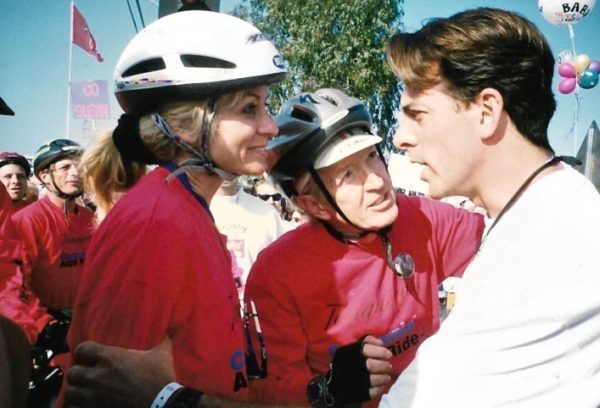
Dan Pallotta with actress Judith Light and her manager Herb Hamsher who rode the last portion of the first AIDS Ride (Photo by Karen Ocamb)
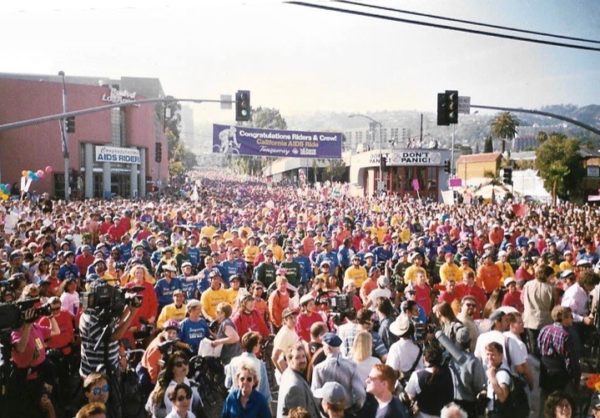
West Hollywood receives thousands of first AIDS Riders and their supporters. (Photo by Karen Ocamb)
“If Rose Green had not been there, I’m not sure it ever would have happened, at least not at that moment or for that organization. She understood the importance of taking a risk, and the rest of the board took comfort in her confidence,” he writes.
Greene’s courage and confidence in taking a risk when necessary to bring about change should serve as a model for others, Pallotta says.
“For all of the thought leadership that has been proffered about social change and risk since 1993, not too much has changed. Peoples’ attitudes toward risk is mostly still, ‘Sure, I’ll take a risk, so long as I know it’s all going to work out.’ But that is not the nature of risk. Rose Greene understood that, before the term ‘social enterprise’ ever even really existed. She was a mensch. A kindred spirit. Authentic. Full of real integrity and a sense of possibility. She loved life and living,” Pallotta writes.
“And damned if she didn’t actually ride the whole 575 miles with us in that very first AIDSRide. By the way, it didn’t net the $600,000 we had projected. It netted $1,013,000,” Pallotta writes. “The world needs more Rose Greenes.”
Greene continued to believe in the power of informed risk-taking. In January, she posted on her Rose Green Cfp Facebook page: “An important, exceptional excerpt about risk from the Behavioral Investor by Daniel Crosby. Remember this paragraph when thinking about investing for the long term (because thinking short term, reacting to negative moves in the market, will easily ruin your chances of success).”
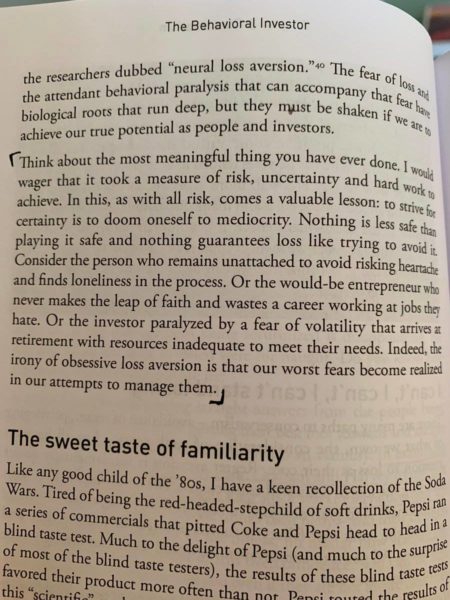
Greene left the Center Board in 1995, but returned 11 years later in 2006, serving until 2011. During that time, California wrestled with marriage equality and then the war over Prop 8 in 2008.
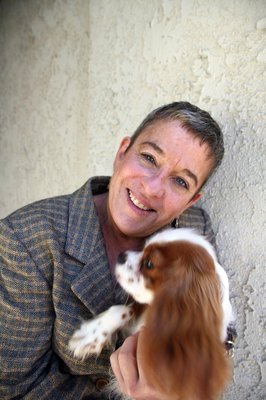
Greene married Helena Ruffin on June 17, 2008, the day after same-sex marriage was officially legalized in California, before Prop 8 was put on the November 2008 ballot.
“Rose taught me to live my authentic life,” Ruffin told The Times, crediting Greene with helping her come out.
“Rose would tell me: ‘The more we tell people who we are, the easier it will be for us to be accepted,’” Ruffin said. For Greene, “it was always about advocacy and always finding places for people who were cast out, and making sure they could find a home and place to be… she fought for people to be treated as equals.”
That sense of equality extended to family. She and Ruffin broke up about 10 years ago but never got divorced and remained very close friends, including with Ruffin’s partner, Shari Robins.
“It’s been a difficult few months to say the least. As many of you know my partner Helena was brutally attacked on March 2nd in an attempted carjacking. The first person I called was Rose Greene, a women who had become my dear friend, and was the wife of, you guessed it Helena. It was complicated, but never for us. Rose was a 4 time cancer survivor and the first time we met, Helena and I promised her we would always take care of her,” Robins wrote on her Facebook page after Greene passed away, detailing how often they all stayed and traveled together.
“We had a really good thing going the 3 of us. When she discovered she had developed a type of bone leukemia, related to all the chemo she had endured, she vowed to do what was needed to make a 5th defense of this insipid disease. She was a fighter,” she wrote. Sadly things did not improve and Rose had really had enough. She agreed to give treatment one more week…. On Monday Helena got a call that things had gone south, Rose’s kidneys were failing. Tuesday Helen said I had to get to LA and I managed to get an earlier flight on Thursday AM Rose was hanging on. I got the COH at 7. O’clock in the car I ordered Din Tai Fung, our special comfort food, to arrive at the hospital when I arrived. Rose was still with us. Helena was telling Rose all day that I was coming and she held on.
“Helen and I and Bernadette, our caregiver, held Rose’s hand and prayed in 3 religions, me Jewish, Helena AntiochIan Orthodox and Bernadette Christian. We let her know she was good to go and that she had fought so admirably hard. She passed peacefully at 9:23 pm on July 11th.
“Our hearts are broken she will be dearly missed. I love you Rosie. Hope you are enjoying that Med Men and Tequila in the sky. Xo Rest In Peace Hon.”
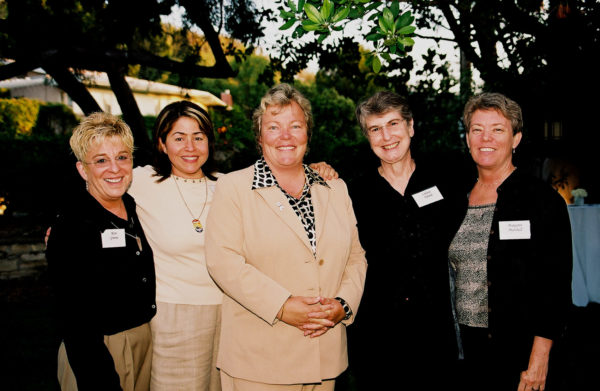
Rose Greene; Helena Ruffin; Lorri L. Jean; Lillene Fifield; and Margaret Marshall (Photo courtesy Los Angeles LGBT Center)
“Rose left this Earth way too early at the age of 72. But she went out fighting following a stem cell transplant in her quest to defeat bone cancer,” Jean says. “The Center is what it is today, thanks in part to Rose’s leadership and vision….Today the Center lauds this tireless champion of the oppressed, this extraordinary, amazing, powerful, hilarious, and loving woman. May she rest in peace.”
Peace and happiness may be what she sought most for herself, her friends, family and clients to enjoy. Last February 27, she posted this on her Facebook business page:
“Our desire for happiness is something we all have in common.
As advisors we have the remarkable connections, intelligence, experience and technology, among other things, to help you plan for the future and invest for retirement but it is compassion that is our most important trait. Our concern for others’ well-being, our clients, whom are our family.
“Cooperation comes from friendship, friendship comes from trust, and trust comes from kindheartedness. Once you have a genuine sense of concern for others, there’s no room for cheating, bullying, or exploitation; instead, you can be honest, truthful, and transparent in your conduct. Be compassionate.” -Dalai Lama”
Five days earlier, she posted this photo, seeing herself and life in perspective: “It’s Friday! There’s a crisp chill in the air but skies are clear and blue. We can see the Hollywood sign all the way from Santa Monica. Though it really isn’t that far away when you look at the actual distance….”
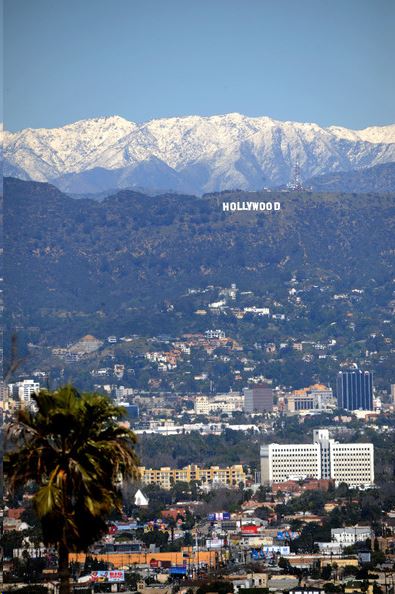
Please note: this article was corrected to indicate that it was Karen Siteman, with Mason Sommers, who launched and did much of the hard work purchasing the old IRS building.
California
Ricardo Lara, John Heilman inducted into Victory Institute’s Hall of Fame
Induction took place in D.C. on Saturday

The LGBTQ+ Victory Institute on Saturday inducted California Insurance Commissioner Ricardo Lara and West Hollywood Vice Mayor John Heilman into its LGBTQ+ Political Hall of Fame.
The inductions took place during the Victory Institute’s annual International LGBTQ+ Leaders Conference in D.C.
U.S. Rep. Robert Garcia (D-Calif.), San Diego Mayor Todd Gloria, San Leandro Councilmember Victor Aguilar Jr., are among those who attended the conference. Evan Low, the LGBTQ+ Victory Institute’s president, served in the California State Assembly from 2014-2024.
Former state Senate President Pro Tempore Toni Atkins, former Assembly Speaker John Pérez, former state Sen. Christine Kehoe, former Palm Springs Mayor Ron Oden, Harvey Milk, a member of the San Francisco Board of Supervisors who was the state’s first openly gay elected official, and José Sarria, who ran for the San Francisco Board of Supervisors in 1961, have also been inducted.
National
Study shows ‘pervasive mistreatment of LGBTQ people by law enforcement’
Findings claim nationwide police misconduct, including in D.C., Va., Md.

The LGBTQ supportive Williams Institute, an arm of the University of California at Los Angeles School of Law, released a report last month citing multiple research studies conducted over the past 25 years showing past and “ongoing” mistreatment of LGBTQ people by law enforcement throughout the United States.
“Findings show that LGBTQ communities – particularly LGBTQ people of color, youth, and transgender and gender nonconforming individuals – have faced profiling, entrapment, discrimination, harassment, and violence from law enforcement for decades, and this mistreatment continues to be widespread,” according to a Williams Institute statement.
“Experiences of police mistreatment may discourage LGBTQ people from reporting crimes or engaging with law enforcement,” Joshua Arrayales, the report’s lead author and Williams Institute Law Fellow said in the statement.
“Reporting crimes is essential for accurate crime statistics, property allocation of crime prevention resources, and support services that address the unique needs of LGBTQ survivors,” he said.
The 59-page report cites the findings of two dozen or more studies and surveys of LGBTQ people’s interaction with police and law agencies for the past 25 years through 2024 conducted by various organizations, including the ACLU, the National Coalition of Anti-Violence Programs, the Williams Institute, and local government agencies.
But the report does not provide a breakdown of where police abuse against LGBTQ people occurred by specific police departments or locations. Instead it provides survey research findings of large groups of LGBTQ people who responded to a survey in different locations of the U.S.
Among other things, those surveys have found “LGBTQ people are more likely than non-LGBTQ people to report being stopped by police, searched by police, arrested, and falsely accused of an offense,” the Williams Institute statement accompanying the report says. “LGBTQ people also report substantial rates of verbal harassment, physical harassment, sexual harassment, and assault,” it says.
The report itself cites surveys of LGBTQ people’s interactions with police in D.C., Baltimore, and Virginia but does not give specific cases or identify specific police departments or agencies.
“A 2022 study based on interviews with 19 Black transgender women from Baltimore and Washington, D.C. identified a theme of re-victimization while seeking help from police,” the report says. “One participant noted that male officers asked what she did to cause her own abuse,” according to the report.
“Other participants expressed that when a knowledgeable officer was present, such as an LGBTQ+ liaison, they felt more inclined to reach out for help,” it says.
The report also states, “A 2024 study based on interviews with 44 transgender people in Virginia documented two instances of transgender women being pulled over for broken tail lights and then being mistreated once officers discovered they were transgender based on their IDs.” The report does not reveal the specific location in Virginia where this took place.
Other locations the report cites data on anti-LGBTQ conduct by police include New York City, Chicago, Los Angeles, Palo Alto, Newark, N.J., and Austin and San Antonio in Texas.
The full report can be accessed at williamsinstitute.law.ucla.edu.
West Hollywood
Administration refused to honor World AIDS Day; residents gathered with defiance, grief and love
Yesterday, members of the APLA Health Writers Group read moving stories to a large group of locals gathered at the AIDS monument.
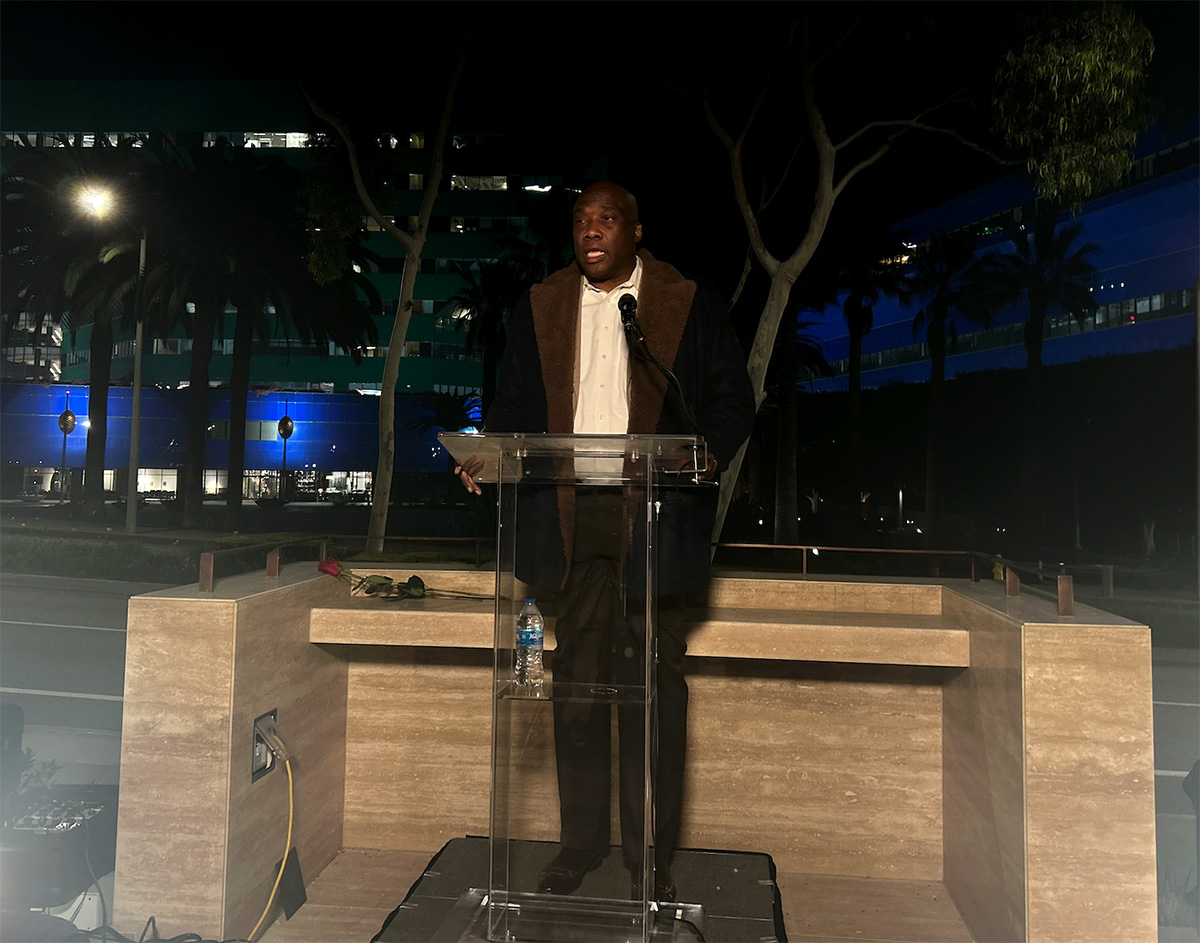
On Monday, the federal administration did not honor World AIDS Day, for the first time since the international awareness day was created in 1988. In addition to significant funding cuts to organizations focusing on HIV preventative treatment and care, the government’s halting of this commemoration perpetuates a dismissive system of inaction against LGBTQ+ people.
And yet, over 50 community members filled the empty spaces of West Hollywood’s AIDS monument yesterday evening, waiting in the night chill as city officials delivered impassioned statements and writers from APLA Health read personal pieces that centered a grief and love for those lost to the epidemic.

Before the readings began last night, West Hollywood vice mayor John Heilman asked for residents to join him in a righteous rage against administrative apathy. “I want to ask us all to reflect for just a moment about all of the people we lost…I want us to reflect and get angry,” said Heilman. “We have a fucking president who won’t even recognize World AIDS Day.”
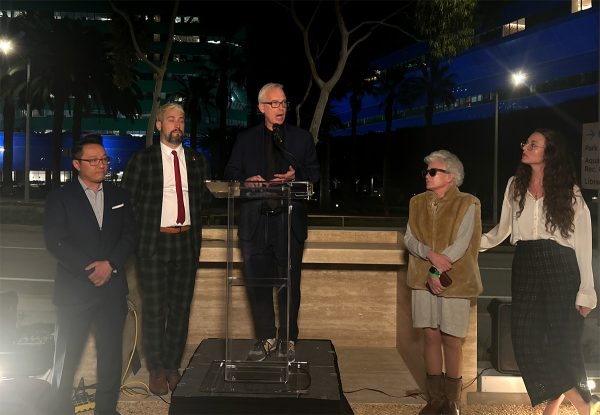
Irwin Rappaport, board chair for STORIES: the AIDS monument, echoed this immense disappointment. “Many of us here tonight lived through the 1980s, so we know what that’s like,” Rappaport said. “We also know that because of that neglect, because of that lack of caring from the federal government, we have to care for one another — and we know how to do that. When we don’t have recognition from others, we know how important it is to preserve our own history, to tell our own stories.”
Through heavy silence, five writers from APLA Health’s writers group stood tall before a podium and shared intimate writings they created about the epidemic and its personal impact on them. The collective was established in 1989 to provide an inclusive, expressive space for HIV-positive writers and allies to work on their writing and learn how to share their stories.
Writer Brian Sonia Wallace, who served as West Hollywood’s poet laureate from 2020 to 2023, has been working with the writers group for the last four years to help them hone and refine their narrative voices as they share their heaviest grief and the depths of their love for the people they lost to HIV and AIDS.
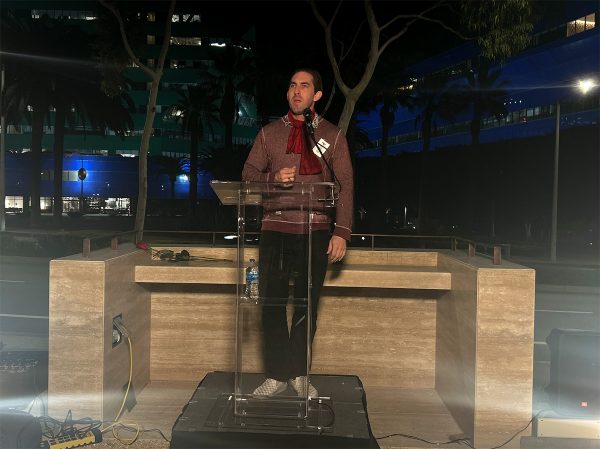
Hank Henderson, one of these writers, read from a diary entry from November 29, 1991. His voice, clear and strong, wavered as he shared about the death of his dear friend Richard. In a piece filled with lush, rich detail, painted clearly with a strong and loving voice, Henderson recounted a memory with Richard during the latter’s last years.
“The Santa Barbara sky is clear blue forever today…Yesterday came and went like a half-remembered dream between snooze alarms,” Henderson recited. “Last year, we walked to the beach. We spent hours there, played frisbee ourselves, brought the dog. Richard even yelled out 30-minute tanning turnover alarms. Yesterday, he took tiny, labored steps back to the car, used my shoulder to keep himself from falling over. Nobody said anything. We just pretend it’s normal.”
Another writer, Austin Nation, shared the story of being told he was HIV-positive at 26 years old. As a young nurse, he remembered the shock of seeing “young, beautiful men” arriving at the hospital covered in “purple, blotchy sores.” When he received his own test results, a paralyzing terror washed over his body. An incredulity followed the fear: why was this happening to him? “I got this thing for what?” Nation spoke. ”For having fun? For making love? And now it’s gonna cost me my life?”
But as he stood before the crowd, now 63 years old, he was met with applause and joy as he stated and repeated: “I’m still here. I’m still here.” The writers, in their grief and loss, have come to a place where they are able to share these stories, empowered and held. “In a world that writes off people with stories like mine,” Nation said. “It’s a hell of a good day to be alive.”
Kristie Song is a California Local News Fellow placed with the Los Angeles Blade. The California Local News Fellowship is a state-funded initiative to support and strengthen local news reporting. Learn more about it at fellowships.journalism.berkeley.edu/cafellows.
National
Faith leaders denounce anti-transgender attacks
‘You are holy. You are sacred. We love you.’
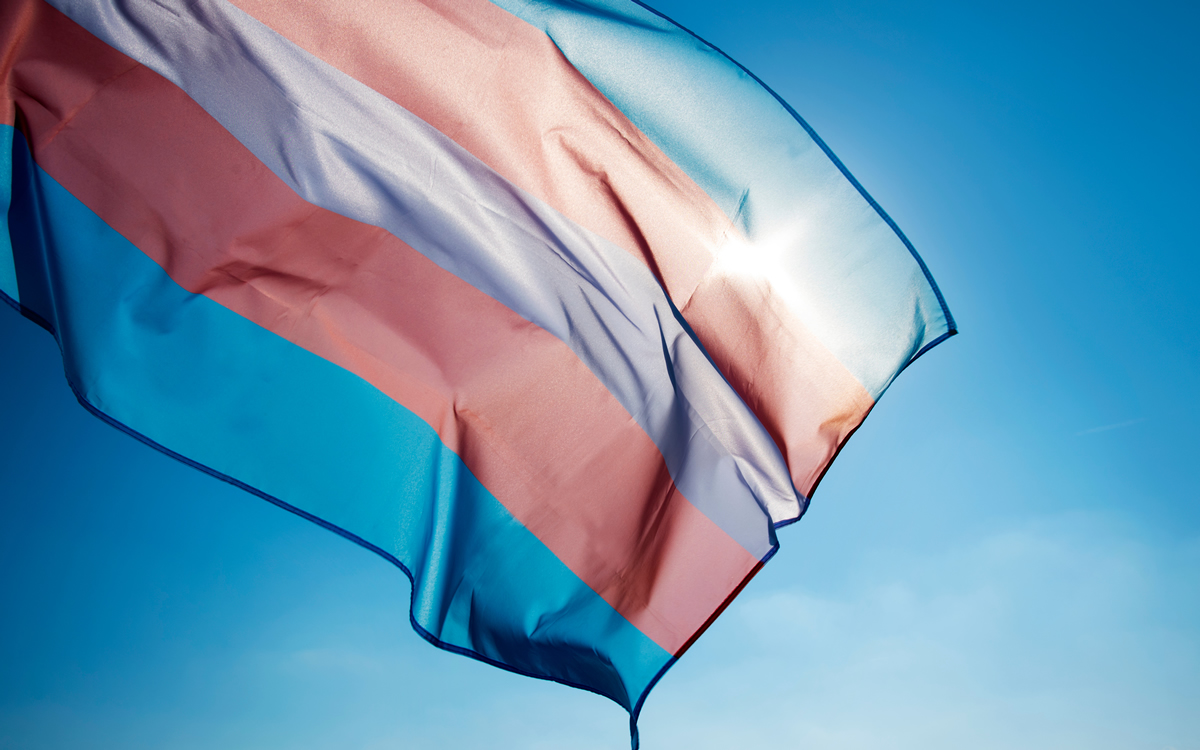
This past Trans Awareness Week, 10 heads of diverse religious traditions issued a statement proclaiming that transgender, intersex, and nonbinary people are worthy of love, support, and protection. Led by Rev. Dr. Sofía Betancourt, president of the Unitarian Universalist Association, representatives from the Universal Fellowship of Metropolitan Community Churches, The Fellowship of Affirming Ministries, the Union for Reform Judaism, the Presbyterian Church, the Christian Church (Disciples of Christ), The Episcopal Church, the United Church of Christ, and Reconstructing Judaism called out the violent and systemic persecution of trans, nonbinary, intersex, and queer people–proclaiming that their faith and their humanity urged them to affirm that trans, intersex, and quere people are “sacred” and “holy.”
Their statement comes at a critical time. Over the past three months, Trump and his Cabinet’s anti-trans rhetoric has only intensified, with a report released late September by journalist Ken Klippenstein in which national security officers leaked that the FBI is planning to classify trans people as “extremists.” By classifying trans people as “Nihilistic Violent Extremists,” far-right groups would have more “political (and media) cover,” as Abby Monteil reports for them, for anti-trans violence and legislation.
While the news is terrifying, it’s not unprecedented – the fight against trans rights and classification of trans people as violent extremists was included in Project 2025, and in the past several weeks, far-right leaders’ transphobic campaign has expanded: boycotting Netflix to pressure the platform to remove trans characters, leveraging anti-trans attack ads in the Virginia governor’s race and banning professors from acknowledging that trans people exist. In fact last month, two Republican members of Congress called for the institutionalization of trans people.
It seems that the government shutdown was predicated, at least partially, on Trump’s own anti-trans policies that were attached as riders in the appropriations bill.
It’s a dangerous escalation of transphobic violence that the Human Rights Campaign has classified as an epidemic. According to an Everytown for Gun Safety report published in 2020, the number of trans people murdered in the U.S. almost doubled between 2017 and 2021. According to data released by the Gun Safety report from February 2024, 34 percent of gun homicides of trans, nonbinary, and gender expansive people remain unsolved.
As Tori Cooper, Director of Community Engagement for the Transgender Justice Initiative for the Human Rights Campaign Foundation, this violence serves a purpose. “The hate towards transgender and gender expansive community members is fueled by disinformation, rhetoric and ideology that treats our community as political pawns ignoring the fact that we reserve the opportunity to live our lives full without fear of harm or death,” Cooper said.
The faith leaders came out in this statement to affirm that it is their spiritual and human imperative to call out this escalating violence and protect trans, nonbinary, intersex, and queer people. The leaders acknowledge that historically and today, religion is used as a weapon of hate to degrade and deny the human dignity of LGBTQ+ peoples. The Supreme Court is hearing Chiles v. Salazar, a case about the constitutionality of a Colorado ban of conversion therapy for minors, with the majority of conversion therapy practices being faith based. And despite the Supreme Court declining to hear a case challenging the constitutionality of same-sex marriage conferred in Obergefell v. Hodges, efforts to end marriage equality remain ongoing with Katy Faust’s End Obergefell movement.
“During a time when our country is placing their lives under increasingly serious threat,” the statement reads, “there is a disgraceful misconception that all people of faith do not affirm the full spectrum of gender – a great many of us do. Let it be known instead that our beloveds are created in the image of God – Holy and whole.”
The faith leaders argue that commendation of LGBTQ peoples and religiously motivated efforts to deny their dignity and rights is not the belief of all faith communities, and far-right Christian nationalist communities and others who uphold homophobia and seek to exact it writ large in the United States do not speak for all faith leaders.
This is a critical piece of the statement and builds on historical precedence. During the 1980s AIDS crisis, when far-right Christian leaders like Jerry Falwell, one of the founders of the Moral Majority, stated that HIV was “God’s punishment” for LGBTQ+ people and indicative of a broader moral decline in America, affirming faith communities came out to affirm the dignity and divinity of queer people. As funeral homes and churches refused to prepare the dead and bury them, some faith communities stepped up to say that these homophobic leaders do not speak on behalf of all people of faith.
In 1985, the United Church of Christ General Synod urged its member congregations to claim and declare themselves “Open and Affirming,” in order to express their welcome and support for LGBTQ+ people, and two years later, the Church of the Brethren issued a statement titled “A Call to Compassion” where conference members urged member congregations to speak out boldly against discrimination, provide direct care to people with HIV/AIDS, and actively educate themselves and others to stop the spread of fear and prejudice surrounding the disease.
Just one year later, the Evangelical Lutheran Church in America Church Council issued a statement, “AIDS and Church’s Ministry of Caring,” which outlined the ways in which welcoming, ministering to and advocating on behalf of people with HIV/AIDS is critical to their mission. Even the US Conference of Catholic Bishops, which earlier this month banned gender-affirming care at Catholic hospitals, issued a statement in 1987 calling discrimination against people with HIV/AIDS “unjust and immoral,” and denouncing the label of “innocent” or “guilty” patients.
Thus, the faith leaders’ statement this past week builds on a rich history of faith communities fighting the stigma that far-right faith groups perpetuate about LGBTQ+ people and committing to action. What sets this latest statement apart is its decidedly interfaith heart, which speaks to the history of the Pride Interfaith Service in Washington, DC that was first started by a group of faith leaders and lay people who gathered at the AIDS Memorial quilt.
As the statement reads, “Our scriptures vary, but they share a common conviction. As we make justice our aim we must give voice to those who are silenced. Our shared values, held across many faiths, teach us that we are all children of God and that we must cultivate a discipline of hope, especially in difficult times. As such, we raise our voices in solidarity to unequivocally proclaim the holiness of transgener, nonbinary, and intersex people, as well as the recognition of the entire spectrum of gender identity and expression.”
The statement ended by arguing that they need to call out the violence they are witnessing. Their silence, they argue, would be in compliance and reinforce the idea that homophobic religious leaders and lay people speak on behalf of all people of faith. Their statement is not only words, however, it is a written promise affirming the dignity and holiness of queer people but also to protect them in the face of increasing violence and persecution.
“When people of faith and conscience stay silent in the face of oppression, we are all made less whole. When people of faith and conscience speak out against that which violates the sacred in its own name, we have the power to stay the hand of sin. Transgender, nonbinary, and intersex people are vulnerable today,” the statement concluded.
“Our faiths, our theologies, and our practices of prophetic witness call on us to say with one voice to transgender people among us: ‘You are holy. You are sacred. We love you. We support you, and we will protect you.’”
West Hollywood
West Hollywood kicks off community-focused programming for World AIDS Day
Since 1988, queer communities have come together on Dec. 1st to honor siblings and allies lost to the AIDS epidemic.
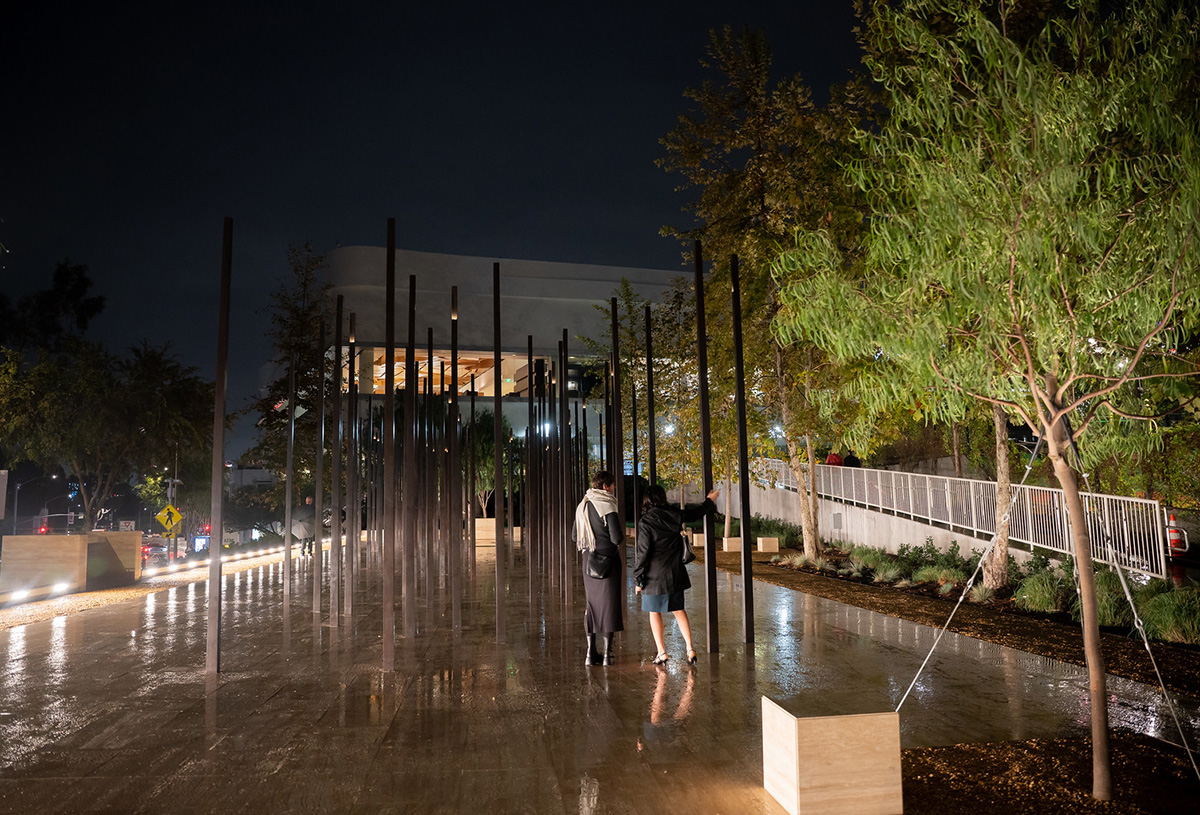
Since 1988, LGBTQ+ communities have come together on Dec. 1st to commemorate queer siblings and allies lost to the AIDS epidemic. This year’s World AIDS Day follows the theme “Overcoming disruption, transforming the AIDS response” and highlights the substantial funding cuts to research, health services, and community initiatives that have prioritized the safety of people with HIV and AIDS. The theme challenges people to think about “radical” ways to organize together and ensure that those who are impacted are able to access the care, treatment, and awareness that they need.
Beginning today, the City of West Hollywood is kicking off programming to recognize the historical transformation that local queer communities experienced during the AIDS epidemic. A panel from the AIDS Memorial Quilt will be available for viewing at the City’s Council Chambers at 625 N. San Vicente Boulevard through Monday, Dec. 15th.
Known as the largest community arts project in history, the Quilt is a powerful memorialization of loved ones who died during the epidemic. Each panel of the Quilt contains a story of remembrance, immortalizing a life cut short during the crisis. The project currently contains over 50,000 panels dedicated to over 110,000 people, all woven together in a 54-ton tapestry piece.
If you’re visiting the panel today, there will be an additional gathering opportunity tonight at the West Hollywood Park for STORIES: the AIDS Monument. From 5:30 to 8:30 p.m., members from the HIV-positive writers collective APLA Health Writers Group will present intimate readings that reflect on their experiences. Community members will be allowed time to wander through the monument and also preview the new Herb Ritts: Allies & Icons exhibition at ONE Gallery after the program. The art show includes striking black and white portraits of activists who stood in alliance with those most impacted during the AIDS epidemic.
Additionally, fresh flowers will be placed on the bronze plaques that line the City’s AIDS Memorial Walk. During the AIDS epidemic, West Hollywood was at the center of a rampant grief and loss that juxtaposed vibrant programming and efforts that boosted healing and fought against stigma and violence. It continues to be a vibrant space that houses various organizations and memorial spots that continue to uphold the revolutionary history and advocacy work that has continued since the epidemic’s beginnings.
Today, West Hollywood is in the process of executing its HIV Zero Strategic Plan, an initiative that began in 2015. Its goals include: expanding healthcare access for people living with HIV and AIDS, reducing the rate of infections, lessening health disparities and inequities for those impacted, and slowing the disease’s progress from advancing to AIDS.
According to West Hollywood mayor Chelsea Byers at a recent Cityhood event, the initiative carries forth the City’s “bold vision” and commitment to ensuring marginalized community members living with HIV do not face the life-threatening discrimination and health barriers that their elders experienced.
To learn more about the City’s programming, read here.
Kristie Song is a California Local News Fellow placed with the Los Angeles Blade. The California Local News Fellowship is a state-funded initiative to support and strengthen local news reporting. Learn more about it at fellowships.journalism.berkeley.edu/cafellows.
West Hollywood
Today, West Hollywood celebrates 41 years of queer cityhood
WeHo’s city officials are trying to preserve the fight for queer safety and rights that began decades before.
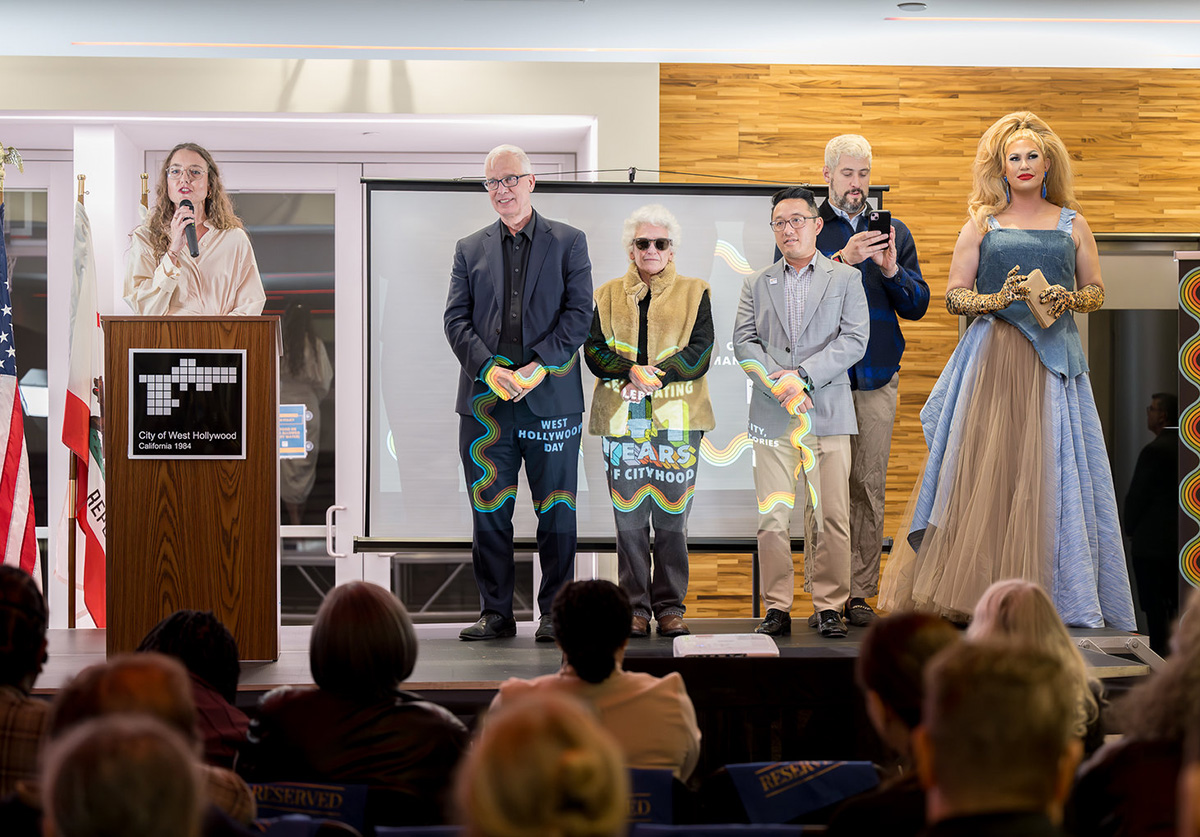
On Nov. 29th, 1984, West Hollywood was incorporated as an independent City, making its sovereignty official and solidifying it further as a sanctuary for LGBTQ+ community members, their stories, and their freedoms. Inspired by other prominent gay neighborhoods like New York’s West Village and San Francisco’s Castro District, West Hollywood was established by local queer advocates and residents. Their first city council was made up of a majority gay governing body — the first in the world, according to the West Hollywood History Center.
This political legacy, and the city’s vibrant and proudly queer history, continues to be preserved. On Monday’s celebratory event, West Hollywood mayor Chelsea Byers announced that the City’s current council “continues to be a majority-LGBTQ+ body,” holding tightly onto a “spirit” that reflects, prioritizes, and fights for Los Angeles’ queer community.
West Hollywood has been through various transformations, cocooning and revitalizing itself through the country’s evolving political and cultural upheavals. It has long been home to a ravishing nightlife that celebrates LGBTQ+ expression, and was a focal point for queer-led liberation and activism in the late 1960s and early 1970s. Trailblazers like Morris Kight led the first gay pride march through West Hollywood’s streets in 1970 and opened the Los Angeles LGBT Center to nourish the City’s robust and blossoming queer communities.
Today, West Hollywood continues to be the place where queer organizers and residents plant roots. Earlier this month, STORIES: the AIDS monument opened up in the City’s park after over a decade of work, shining a light on the legacies of gay activists, artists, historians, and community members who fought to survive as anti-gay stigma led to the erasure of their rights and lives.
As waves of anti-LGBTQ+ hate and violence continue to surge through the country, West Hollywood elected officials aim to continue doing the critical work that began decades before them: the work that protects the ability of queer residents to advocate for themselves, to live with protections and dignity, and to relish in joy. Mayor Byers is inspired by the resilience of the community members who stood together to establish this independent City in 1984. “The people who lived here…wanted a city with strong protections for renters, with progressive policies, and with a local government that would actually reflect and protect the people who call this place home,” said Byers, at the Nov. 24th celebration.
Over 40 years later, these needs have not changed. The way forward? Remembering and fighting for that initial promise and hope. “We are a chorus. We are a tapestry,” said Byers. “We are the product of thousands of people who, for more than four decades, have dared to say: We can build something better here.”
Kristie Song is a California Local News Fellow placed with the Los Angeles Blade. The California Local News Fellowship is a state-funded initiative to support and strengthen local news reporting. Learn more about it at fellowships.journalism.berkeley.edu/cafellows.
Crime & Justice
SoCal gay couple alleges Uber driver refused them service and “chased” them with a bat
Los Angeles attorney Brian Breiter is assisting the couple with civil claims against the driver and Uber, calling into question queer safety on rideshare apps.
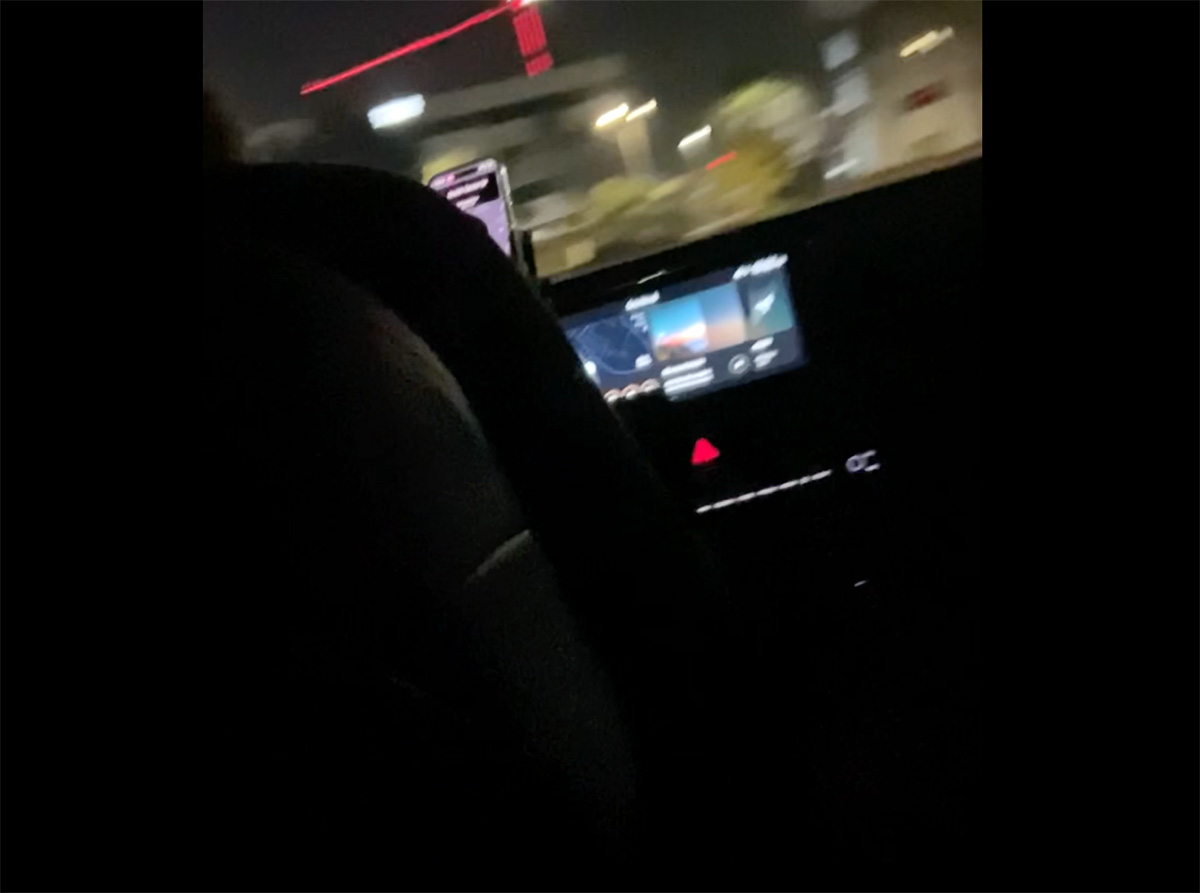
Note: The couple’s names have been kept anonymous by their attorney to avoid retaliation from Uber. They will be referred to as “J.” and “D.”
On Saturday, Nov. 8th, J. and D. shared a kiss during their Uber ride in San Diego’s queer-friendly North Park neighborhood when, suddenly, their driver pulled off the freeway. When the couple alerted him that he had taken the wrong exit, the driver said he would be letting them out because he did not “support [their] kind,” according to J.
It was at this point that J. began to record the interaction. In a 21-second clip provided to the Blade, J. and D. can be heard questioning the driver why they are being told to leave the vehicle when they had not yet arrived at their destination. Stranded in unfamiliar surroundings late at night, the couple responded in shock when the driver replied: “Because I don’t support you.”
In the video, J. asked explicitly: “You don’t support gay people?” to which the driver said: “No.”
J. and D. allege that after pulling over, the driver stepped out, retrieved a bat from his trunk, and cocked it back as if to strike them. At this point, the couple bolted, frantically running while dialing for the police. They ducked behind cars, panicking and hiding while waiting for officers to arrive. “I haven’t experienced another time in my life where I would say that I really was in fear of dying,” D. told the Blade. “We were just hiding there, hoping that we were going to survive at that point.”
Since then, the couple has sought out Los Angeles attorney Brian Breiter to represent them in a civil claim against the driver and Uber. Breiter explains that he is in the process of drafting the lawsuit, which includes claims of intentional infliction of emotional distress and civil assault against the driver as well as claims of negligent hiring, screening and training against Uber.
Breiter told the Blade that since his office sent a representation letter to Uber, there has been minimal contact from the company — no concessions, apology or accountability.
But, a spokesperson claims they have taken one concrete action in the case.
“Everyone deserves to feel safe, welcome, and respected when using Uber. Hate has no place in our society, and we do not tolerate any form of discrimination on the Uber platform,” an Uber spokesperson wrote to the Blade. “As soon as this was reported to us, we banned the driver from the platform.”
While this bit of news has been “relieving” for J. and D., it does not necessarily signal Uber’s readiness to improve their hiring, screening or training guidelines to protect their LGBTQ+ riders. “Removing this one driver does not prevent this from happening again,” Breiter told the Blade. “Unless Uber implements meaningful safety measures and proper screening, LGBTQ+ passengers and the public at large remain at risk.”
In October 2023, Uber Mexico created an LGBTQ+ mobile training initiative to strengthen their non-discrimination policy — but it remains unclear whether this training has been implemented more widely throughout the platform.
LGBTQ+ safety on these rides continues to be an understated issue, and J. and D.’s stories are not singular. On online forums, queer people have long shared their experiences with harassment and discrimination based on their gender and sexual identities. They take to the internet to warn others, understanding that: when there is no systemic change, they must rely on one another to be heard and to protect their communities.
Today, J. and D. do not feel safe using Uber or other rideshare apps. They are constantly reassessing and second-guessting their behaviors in public, for fear of violence. “We’re both very traumatized over this incident. [Recently] we went to dinner and we didn’t want to hold hands in public,” said J. “Because when we did kiss in the Uber, this man hate-crimed us and chased us down the street…It has just been really overwhelming and emotionally and physically draining.”
Kristie Song is a California Local News Fellow placed with the Los Angeles Blade. The California Local News Fellowship is a state-funded initiative to support and strengthen local news reporting. Learn more about it at fellowships.journalism.berkeley.edu/cafellows.
Los Angeles
LGBTQ+ community calls out Radio Korea over host’s homophobic comments; station acknowledges but skirts accountability
On Nov. 3rd, Radio Korea host Julie An claimed that “gay people began the spread of AIDS” on a talk show broadcast by the station.
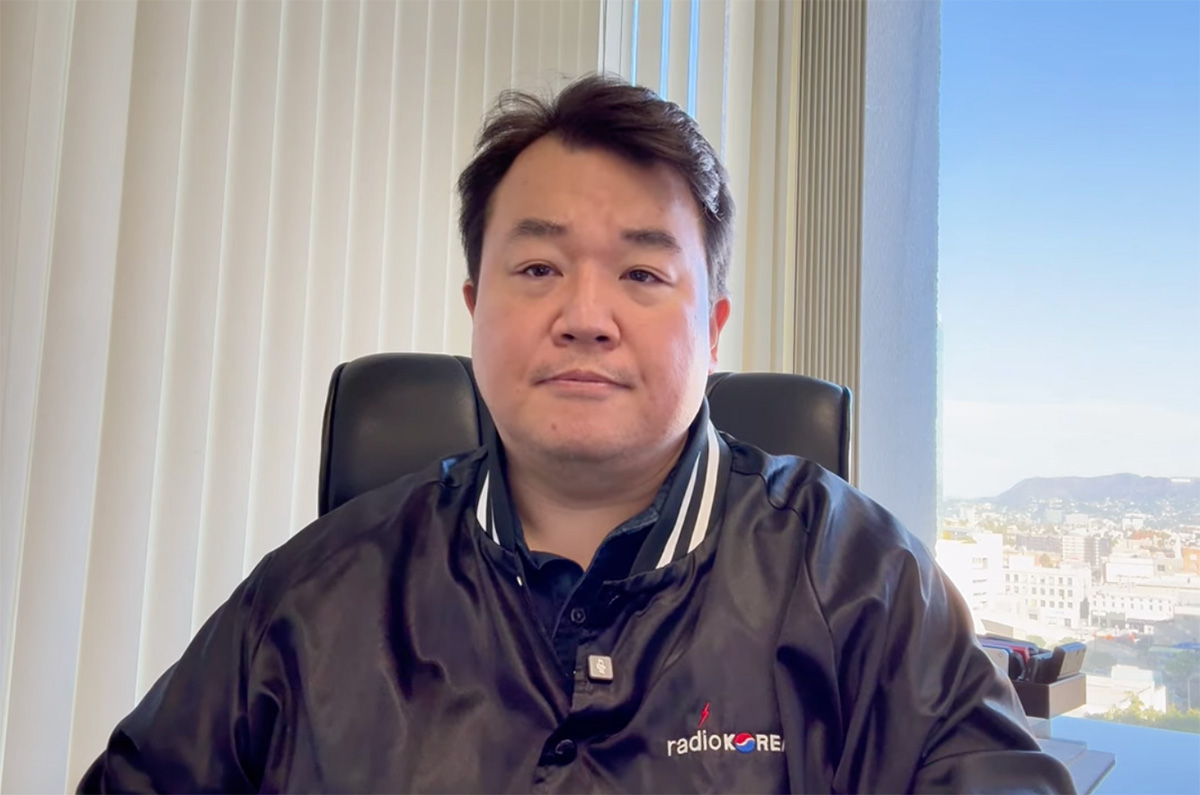
On Monday, Nov. 3rd, Radio Korea aired its regular morning talk show program, where one of its hosts, Julie An, discussed her lack of support for the LGBTQ+ community, citing her religious beliefs. She also went on to comment that gay people spread HIV and AIDS, and that conversation therapy — which has been linked to PTSD, suicidality, and depression — is a viable practice. Clips of this have since been taken down.
Radio Korea offers Korean language programming to engage local Korean American and Korean immigrant community members. Its reach is broad, as Los Angeles is home to the largest Korean population in the U.S, with over 300,000 residents. As An’s words echoed through the station’s airwaves, queer Korean community members took to social media to voice their concern, hurt, and anger.
In a now-deleted Instagram post, attorney, activist, and former congressional candidate David Yung Ho Kim demanded accountability from the station. Writer and entertainer Nathan Ramos-Park made videos calling out Radio Korea and An, stating that her comments “embolden” people with misinformation, which has the ability to perpetuate “violence against queer people.”
Community health professional Gavin Kwon also worries about how comments like An’s increase stigma within the Korean immigrant community, which could lead to increased discrimination against queer people and their willingness to seek health care.
Kwon, who works at a local clinic in Koreatown, told the Blade that comments like An’s prescribe being gay or queer as a “moral failure,” and that this commonly-held belief within the Korean immigrant community, particularly in older generations, strengthens the reticence and avoidance clients hold onto when asked about their gender or sexual orientation.
“When you stigmatize a group, people don’t avoid the disease — they avoid care,” Kwon explained. “They avoid getting tested, avoid disclosing their status, and avoid talking openly with providers. Stigma pushes people into silence, and silence is the worst possible environment for managing any infectious disease.”
For weeks, Radio Korea did not offer a direct response to the public criticism. Its Instagram feed continued to be updated with shorts, featuring clips of its various hosts — including An.
On Friday, Radio Korea CEO Michael Kim released an official statement on the station’s YouTube page. In this video, Kim stated that An’s comments “included factual inaccuracies” and that the station “does not endorse or share the personal opinions expressed by individual hosts.” Kim also stated that Radio Korea “welcomes members of the LGBT community to share their perspectives” in order to deepen understanding through dialogue.
Afterwards, Kim continued that though he acknowledges the “pain” felt by queer community members, he concluded: “I don’t think Radio Korea needs to apologize for what was said any more than Netflix should apologize for what Dave Chappelle says, or any more than Instagram or TikTok should apologize for what people say on their platforms.”
Kim then offered a justification that An’s statements were “not part of a news report,” and that he was “disappointed” that David Yung Ho Kim, specifically, had been vocal about An’s comments. Kim stated that he was the first person to interview David in 2020 during his congressional campaign, and that he had provided the candidate a platform and opportunity to educate listeners about politics.
“After all these years, the support Radio Korea has given him,” said Kim, “the support I personally gave him, even the support from other Radio Korea members who donated or even volunteered for him — he dishonestly tried to portray Radio Korea as being an anti-gay organization.”
Kim went on to criticize David’s purported “hurry to condemn others,” and also questioned if David has disowned his father, who he states is a pastor. “What kind of person is David Kim, and is this the kind of person we want in Congress?” Kim asked viewers, noting that Koreatown is “only about three miles from Hollywood, and some people just like to perform.”
At the end of the video, Kim stated that his duty is to guard the legacy of the station. “My responsibility is to protect what was built before me and ensure that Radio Korea continues serving this community long after today’s momentary controversies disappear,” Kim said.
For community members and advocates, this response was unsatisfactory. “The overall tone of the statement felt more defensive than accountable,” Kwon wrote to the Blade. “Instead of a sincere apology to the LGBTQ+ community that was harmed, the message shifts into personal grievances, political dynamics, and side explanations that don’t belong in an official response.”
Kim’s portrayal of the criticism and calls to action by community members as a “momentary controversy” paints a clearer picture of the station’s stance — that the hurt felt and expressed by its queer community members is something that will simply pass until it is forgotten. An continues to be platformed at Radio Korea, and was posted on the station’s social media channels as recently as yesterday. The station has not outlined any other action since Kim’s statement.
Kristie Song is a California Local News Fellow placed with the Los Angeles Blade. The California Local News Fellowship is a state-funded initiative to support and strengthen local news reporting. Learn more about it at fellowships.journalism.berkeley.edu/cafellows.
Los Angeles
Forgetting queer pioneer Morris Kight is “impossible”: Advocates and friends share stories at remembrance
On Saturday, Nov. 22nd, Kight’s ashes were interred at Hollywood Forever Cemetery.
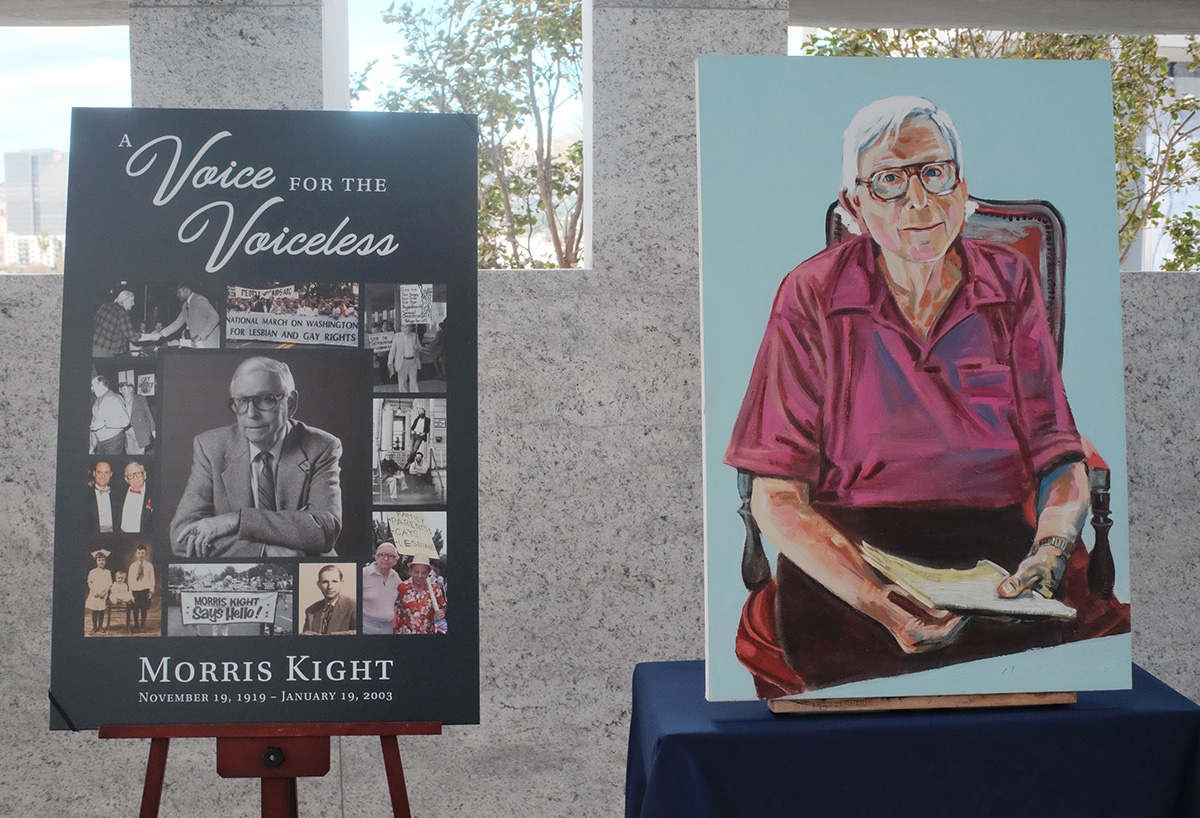
Over 50 people made their way to the rooftop chapel at Hollywood Forever Cemetery’s Gower Mausoleum on Saturday afternoon, taking in sweeping views of the city as a gentle wind began to envelop the space — a wind that some thought signaled the presence of Morris Kight. Hosted by local nonprofit AIDS Healthcare Foundation (AHF), this reception provided longtime friends, fellow activists, and anyone else impacted by Kight’s legacy with the opportunity to share some of their most memorable stories about the LGBTQ+ vanguard.

Kight died on January 19, 2003, after decades of leading peaceful, bold, and outspoken action against oppressive systems that targeted marginalized communities. As Congresswoman Maxine Waters declared at the remembrance event: “You have to be a hell of somebody to be memorialized 22 years after.”
Kight co-founded the Los Angeles LGBT Center in 1969, first known as the Gay Community Services Center, where so many queer youth and adults found the courage and empowerment to seek education, resources, and comfort. It became the place where they could fully embrace themselves.
At 19, AHF president Michael Weinstein found himself at the front steps of the Center, afraid but compelled. This is where his and Kight’s lives would intertwine, setting him on his own path of liberatory leadership. This first encounter and relationship “cemented” his identity, Weinstein told the crowd, after an arduous search for belonging and internal understanding.
The impact Kight had on Weinstein and innumerable other queer folks was not just a consequence of his work, but the purpose for it all. “We were his payment. We were his reward,” said Miki Jackson, Kight’s longtime friend and another instrumental voice in early LGBTQ+ movements. “Morris cared that we were loud enough, we were out enough, we were visible enough that a child in Kansas in elementary school would know about it. He cared about where people were wounded the most.”
Kight projected his voice in hopes it would reach those who were silenced, becoming the face of several important movements, including the Gay Liberation Front. He raised money for people with AIDS, co-founded the Stonewall Democratic Club, and pushed for L.A.’s first pride parade in 1970 — unabashedly fighting for the visibility of LGBTQ+ people as they were met with societal violence and rejection.

“The idea of forgetting a Morris Kight is basically impossible,” said Terry DeCrescenzo, one of the founders of the Gay Academic Union. She recounted fond memories with Kight, including a story tied with her roots of protesting. Together, they blocked the streets of Sunset and Larrabee and sang the civil rights anthem “We shall overcome.” At first, DeCrescenzo was in disbelief. “I thought, ‘I went to Catholic school for 17 years to sit on the sidewalk singing We shall overcome?’ And the answer is yes. He showed me a way of doing things — of approaching life — that I didn’t dream I was capable of. So I thank you, Morris. I love you. I miss you.”
Kight’s ashes have been officially interred at Hollywood Forever Cemetery, granting him a final resting place. In life, he built sites of belonging for queer people, and today, this ground joins a tender catalog of spaces that contains a trace of what his loved ones hope he is remembered for: the fierce kindness with which he led his life. His endless stories. His desire to be with and fight for the people he loved.
Saturday’s remembrance event also offered a moment of deep reflection for the future of local queer activism. “We’re what we have left,” said Jackson, a queer elder who marched alongside Kight in the country’s early days of LGBTQ+ protesting — and who paved a path for younger advocates like Congressman and Equality Caucus Chair Mark Takano to continue the fight. “May we honor Morris by carrying his fire forward until every LGBTQ+ person in this country can live safely, open and unafraid,” said Takano.
Kristie Song is a California Local News Fellow placed with the Los Angeles Blade. The California Local News Fellowship is a state-funded initiative to support and strengthen local news reporting. Learn more about it at fellowships.journalism.berkeley.edu/cafellows.
Los Angeles
The Los Angeles LGBT Center has reopened and upgraded its community tech hub
The David Bohnett CyberCenter provides free access to important tech resources for LGBTQ+ community members.
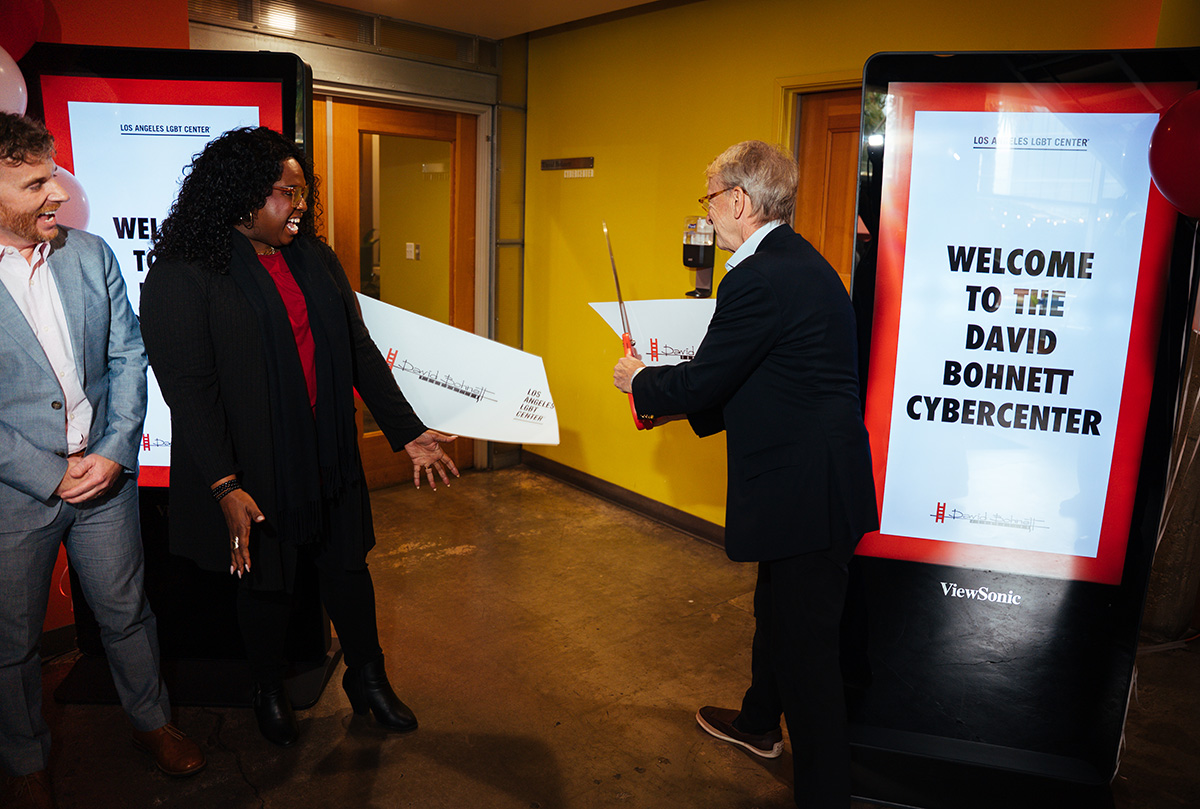
On Thursday, community leaders and advocates gathered at the Los Angeles LGBT Center for a joyous ribbon-cutting event that ushered in the organization’s revamped tech hub. For 27 years, the organization’s David Bohnett CyberCenter has provided local residents a safe space to utilize computers, printers, scanners, and attend workshop opportunities to build their tech literacy skills, stay connected, discover joy, and research important opportunities.
Here, individuals can safely surf the web, complete online benefits and services forms, apply for jobs, as well as make progress towards educational programs. It’s a safe space where LGBTQ+ community members can reliably use technology that can provide them with vital avenues into improving and living their lives.
The CyberCenter is funded by the David Bohnett Foundation, which provides grants to various LGBTQ+ initiatives and social programs nationally in order to improve equity for different marginalized communities. In 1998, the foundation established its first tech hub at the Los Angeles LGBT Center, so that queer community members would not be shut away as technological advancements made online access increasingly necessary. “The idea was simple but urgent,” Bohnett said at yesterday’s ceremony. “[It was meant] to ensure that LGBTQ+ people had access to the technology that could open doors to education, employment, and connection.”

Yesterday, this CyberCenter’s updated facilities were welcomed with warm applause, cheer, and a celebratory banner that was cut by Bohnett himself. It marked an evolving growth towards the foundation and the Center’s shared commitment to the hub’s initial promise: to guarantee equitable technological access to the county’s queer residents.
“Our community members regularly share how missing even one piece of access—a computer, a quiet place to work, a stable connection—can stall their progress,” said Sydney Rogers, senior program manager at the Trans Wellness Center. “For so many, technology isn’t just a tool—it’s the gateway to opportunity. Résumés, job searches, online trainings, interview prep—all of it depends on having access to reliable equipment and an environment where people feel safe and supported.”
For Bohnett, what began as a room with a “handful of computers” has grown into over 60 CyberCenters nationwide — and they are all “rooted in the belief that digital access is not a luxury, but a lifeline,” said Bohnett. “Every time I’m back here, I’m reminded that the Los Angeles LGBT Center was the first to bring that vision to life.”
The David Bohnett CyberCenter is open from Tuesdays to Thursdays, from 10 a.m. to 1 p.m., and from 2-5 p.m. More information about its location and services can be found here.
-

 National4 days ago
National4 days agoStudy shows ‘pervasive mistreatment of LGBTQ people by law enforcement’
-
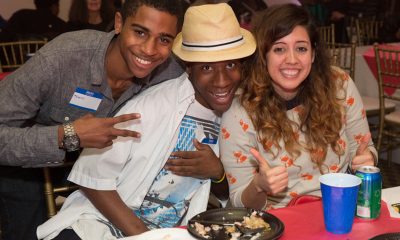
 Events5 days ago
Events5 days agoC.I.T.Y. x1 Youth Group empowers queer youth at free holiday dinner this Sunday
-

 a&e features2 days ago
a&e features2 days agoUltimate guide to queer gift giving
-

 Movies4 days ago
Movies4 days agoA bad romance is brought to light in ‘300 Letters’
-
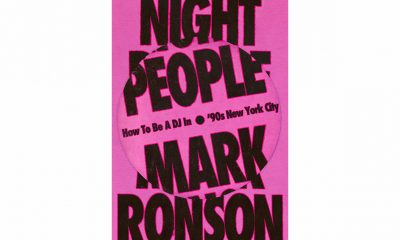
 Books3 days ago
Books3 days ago‘90s club kids will love Mark Ronson’s new book
-

 Golden Globe Awards2 days ago
Golden Globe Awards2 days agoCynthia Erivo, Eva Victor, and ‘Blue Moon’ bring queer representation to Golden Globe film nominations
-
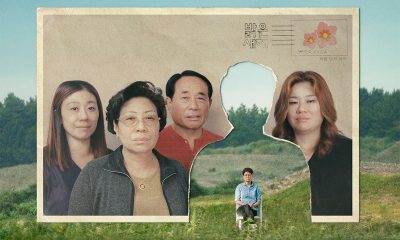
 a&e features14 hours ago
a&e features14 hours ago“I should have been there”: A queer Korean adoptee finds healing with original family members
-
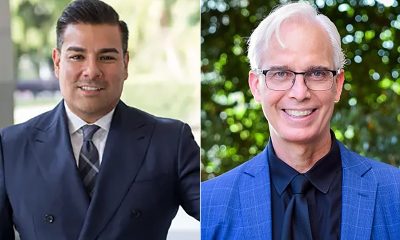
 California19 hours ago
California19 hours agoRicardo Lara, John Heilman inducted into Victory Institute’s Hall of Fame

